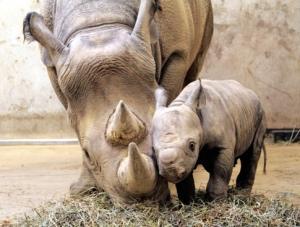by Blake Deppe / People’s World

The black rhino had not been seen in West Africa since 2006, and had been on the IUCN’s Red List of Threatened Species since then.
“The situation could have had very different results if the suggested conservation measures had been implemented,” said Simon Stuart, chair of the IUCN species survival commission. “These measures must be strengthened now, specifically managing habitats in order to improve performance, preventing other rhinos from fading into extinction.”
Jane Smart, director of the IUCN’s global species program, added, “We have the knowledge that conservation works if executed in a timely manner; yet, without strong political will in combination with targeted efforts and resources, the wonders of nature and the services it provides can be lost forever.”
In addition to lack of protection, poaching plays a major factor in the dwindling rhinoceros population. The World Wildlife Fund said that what is believed to be the last remaining Javan rhino in Vietnam was killed by poachers in 2010; it had been found dead with a bullet in its leg and its horn removed. Though other Javan rhinos probably live elsewhere, that species is expected to face extinction next, if the situation does not change.
There are only an estimated 29,000 rhinos remaining worldwide. The animals are coveted in certain countries due to the false belief that their horns can cure or fend off cancer. Poachers have capitalized on this superstition and dehorned thousands of the animals in multiple countries – even in national parks.
There are reports, however, of a recent crackdown on poaching in Vietnam, including the sales and trading of the ill-begotten horns, of which both Vietnam and China are large consumers. Two rhino horns were recently seized by customs officials; the substance had most likely come from South Africa, and was worth an estimated $365,000. Vietnam has now announced it will cooperate with South Africa in order to strengthen the crackdown. Initial steps will include setting up a gene bank and DNA analysis training to better track horns that are taken by poachers.
The two governments will also focus on stopping poachers who obtain hunting permits under false pretenses by masquerading as trophy hunters.
South African government spokesperson Peter Mbelengwa remarked, “As part of the cooperation between the two countries, Vietnam is going to provide us with a list of accredited trophy hunters. We will be able to verify their legitimacy.”
But experts say that even the most admirable efforts to combat the problem cannot be perfect, comparing such campaigns to games of “whack-a-mole,” where when one poaching tactic is defeated, another emerges somewhere else, or in another form.
“The issue seems to be that every time there’s a clampdown in one area, another situation emerges,” said Dr. Jo Shaw, a rhino expert for the World Wildlife Fund. And the situation is just as dire for rhinos in South Africa as they are elsewhere: in 2012 alone, 668 rhinos were killed by poachers. 232 have been killed so far this year. Unfortunately, Shaw concluded, “the patterns indicate that, this year, it will be over 800.”
Photo: LaertesCTB/Flickr (CC)

